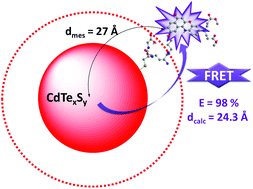Thin-coated water soluble CdTeS alloyed quantum dots as energy donors for highly efficient FRET†
Abstract
The synthesis of highly luminescent water soluble CdTexSy quantum dots (QDs) is described and their elemental composition and optical properties are fully characterized. Glutathione (GSH)-capped nanocrystals were obtained from an aqueous solution of CdCl2, Na2TeO3 and GSH in the presence of NaBH4 upon heating at 100 °C. Spherical CdTexSy alloyed nanoparticles with diameters ranging from 2 to 4 nm were formed, and characterized by X-ray powder diffraction and Transmission Electron Microscopy. Their elemental composition was determined from Inductively Coupled Plasma Atomic Emission Spectroscopy and CHN elemental analysis experiments. A model for the determination of their molecular formulas, molecular weights and extinction coefficients is proposed. Surface GSH molecules were involved in amide bond formation with fluorescent Nile-Red molecules, to be used as energy acceptor in Förster resonance energy transfer (FRET) experiments. FRET was observed from the CdTexSy core (λex = 430 nm) to the Nile-Red dye (λem = 648 nm) with an almost quantitative FRET efficiency (ηFRET = 98%). A detailed analysis of the FRET is presented, revealing a core–dye distance of 24 Å, in very good agreement with the estimated radius of the core (13 Å) as measured by TEM. The QDs present excellent photophysical properties (QY up to 29%), easy synthesis and can be isolated as solids and redispersed in water without loss of their photoluminescence efficiency.


 Please wait while we load your content...
Please wait while we load your content...